updated: 11-9-2022
Top 16 natural brain stimulants and cognitive enhancers.
Everyone wants to function at their highest capacity.
So how do we do maintain high energy levels?
First and foremost, there is no substitute for a good night’s sleep.
Exercise, go to bed early, wake up and attack the day. These basic lifestyle choices do much to boost your brain power and keep you focused throughout the day.
In addition, our energy level and mental powers are influenced by the foods we eat and the beverages we drink.
Fortunately, we share this planet with many edible plants and mushrooms that can energize our body and activate our minds.
Below we describe the 16 most popular natural stimulants for our mind and body.
Click on a natural brain stimulant below to learn more
(…or scroll down and read the whole article.)
This page on herbal stimulants is intended as a general educational resource.
- The products on this page have not been reviewed by the FDA. For any safety concerns, consult with your physician.
Huperzine-A
Huperzine-A is a fascinating chemical. It is often described as a natural nootropic.
Nootropics are smart drugs or cognitive enhancers. They are thought to improve focus, memory, and cognition.
Huperzine-A is considered a natural nootropic because this chemical is produced naturally by a plant called the toothed clubmoss (see photo).
The scientific name for this moss is Huperzia serrata. It belongs in an ancient group of plants called the lycopods. Hyperzia serrata is native to Japan and southeast Asia.
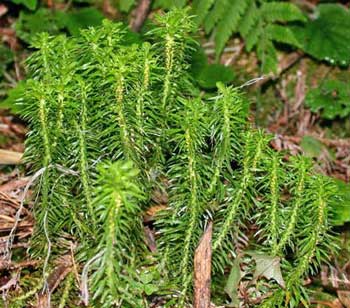
Photo: Keisotyo (CC BY-SA 3.0)
Huperzine-A naturally occurs in this clubmoss plant
The Huperzine-A chemical is classified as an acetylcholinesterase inhibitor. That’s a long word that won’t mean much to most people.
To make a long story short, an acetylcholinesterase inhibitor can prevent the breakdown of acetylcholine. Our brain and muscles need acetylcholine in order to communicate and operate properly. If more acetylcholine stays in the brain – there can be an improvement in brain function.
2020 update: Human clinical studies demonstrate how Huperzine-A may help prevent the loss of mental function in Alzheimer’s patients. Alzheimer’s remains a deadly neurodegenerative disease with no treatment available on the market. You can read more about Huperzine-A and Alzheimer’s research with this recent study here, and this analysis and this study.
EthnoHerbalist recommends…
Huperzine-A is sold as a brain stimulant in a very popular supplement called Alpha Brain. Alpha Brain capsules contain Huperzine-A as well as other plant-based brain enhancers: cat’s claw, bacopa and oat straw. If you’ve ever listened to the Joe Rogan podcast, you already know he is constantly talking about Alpha Brain.
2022 update: Onnit, the company that creates Alpha Brain, is currently giving away a free trial bottle of Alpha Brain capsules. They will charge you a few bucks for shipping and handling…. Here’s the link for a free bottle.
Lion’s mane
Lion’s mane is an edible and medicinal mushroom. You may have already eaten lion’s mane in a Chinese dish. It’s often used as substitute for pork in Asian vegetarian meals.
Lion’s mane grows in clumps along the sides of hardwood trees in North American and European forests. This odd looking mushroom also goes by the name bearded tooth mushroom. If you’ve ever seen the lion’s mane, then that name will make a lot of sense. This odd creature is shaped like a pile of long white teeth (see photo).
Its scientific name is Hericuium erinaceus.
Lately, there’s been a lot of medical interest in this mushroom. A collection of scientific papers have explored the connection between lion’s mane and brain activity.
The results suggest that lion’s mane can stimulate new brain cells and enhance cognitive function. Paul Stamets, the famed mycologist, wrote a nice summary of these scientific findings in this Huffington Post article.
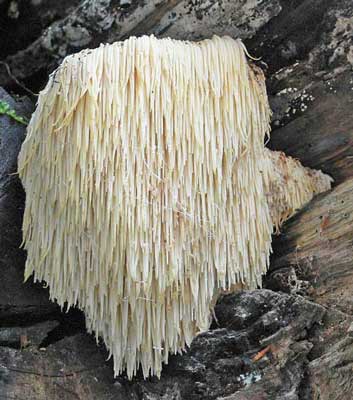
Photo: Lebrac (CC BY-SA 3.0)
Lion’s mane mushroom growing on fallen tree
Here are a few highlights from the Paul Stamet article:
A Japanese research group performed a trial on a group of adults with mild cognitive impairment. Cognition is defined as the action of acquiring new knowledge and thinking. The researchers wanted to know if treatment with lion’s mane would result in cognitive improvements in this group. The HDS-R Hasegawa Dementia Scale was used to measure cognition. After 8 weeks of treatment, the group taking lion’s mane showed significant improvements in terms of their cognitive issues. These results suggest that lion’s mane can improve mental processing.
Another report looked at the ability of lion’s mane to encourage brain cell activity. In order for our brain cells, or neurons, to function properly – they require communication with a small protein called neurotrophic growth factor (NGF). Biologists tested the ability of four different mushrooms to activate NGF expression. Lion’s mane was the only mushroom that caused a positive effect on NGF activity. The authors conclude that certain chemicals found in lion’s mane can activate NGF gene expression.
Activated NGF levels would certainly have an effect on brain cell activity. More research is needed, but it certainly seems that there’s a connection between our brain’s performance and this odd shaped mushroom.
EthnoHerbalist recommends…
Lion’s mane mushroom makes a nice addition to a stir-fry dinner. You may be able to find fresh lion’s mane in the produce section of your local gourmet supermarket.
If you’re interested in a quality lion’s mane supplement, I recommend these Lion’s Mane Capsules by Host Defense. Host Defense is Paul Stamet’s mushroom company and he is a well known personality and spokesperson for the mushroom community. Here is his latest movie on the power of mycology.
Chaga
Chaga is an odd type of mushroom that grows in northern latitude forests. This fungus grows in large, chunky discs on the side of conifer trees. When you split the fungus open, you often find a rich, orange color. Chaga grows happily in Siberia, Canada and within the Adirondack Mountains along the northeastern side of the US.
Due to its extreme growing habitat, chaga is routinely exposed to extreme environmental stress such as UV radiation, harsh winters and predation from aggressive insects. In an attempt to defend itself against these threats, chaga has evolved a collection of biologically active chemical compounds that help protect against these environmental conditions.
When mammals eat chaga, these active compounds transfer into our body and often engage with our own physiology. Oddly enough, many of the chemicals that are densely packed into chaga will also engage with the cells in our body to produce some type of noticeable effect. On this page, I delve deeply into many of the health benefits of chaga mushrooms and I describe the compounds that generate these effects.
Interestingly, chaga tea has been reported to deliver a subtle boost of energy. Personally, I drink chaga tea most afternoons. This is very intentional. If I drink coffee in the afternoon I won’t sleep well. However, chaga has no effect on my sleep because there is no caffeine in chaga.
In fact, it is not clear exactly which chaga chemicals deliver a lift of mood and a boost of stamina. Perhaps we need the whole collection of chaga chemicals? I have read one report, which mentions that sterols, a ring-like chemical structure, are the compounds in chaga that invigorate our body. These sterols promote the pumping action of our heart and thereby increase blood flow and metabolism.
EthnoHerbalist recommends…
Many people prefer their Chaga in a liquid, tincture form. This Host Defense, Chaga Extract bottle contains about 60 servings. You can add a few drops to a smoothie or into your morning coffee.
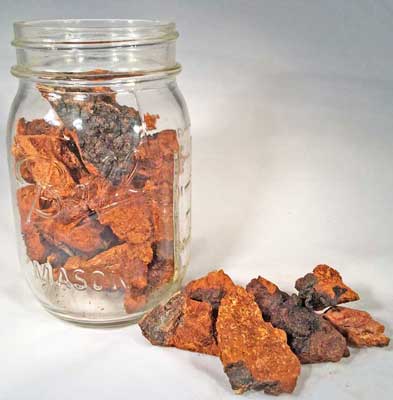
Colorful chunks of Chaga mushroom
Coffee
Any self-respecting list of natural stimulants has to discuss coffee. Coffee remains one of the most commonly consumed beverages in the world.
Coffee beans are actually seeds from the fruit of a green, leafy shrub from the Rubiaceae family (see photo). The two species of Coffea shrub most commonly grown for coffee beans are Coffea arabica and Coffea canephora. Both species are native to Africa.
- Coffea arabica is native to the southwestern highlands of Ethiopa, Sudan and Kenya.
- Coffea canephora is native to the upland forests of Ethiopa.
Coffee is stimulating because it contains 3 different xanthine allakoids: caffeine, theobromine and theophylline.
Xanthines are a group of chemicals that feature a circle structure composed of nitrogen and carbon atoms. They are well known for their ability to stimulate the human body.
As most people know, the primary stimulant in coffee is caffeine.
So, how does caffeine work?
Caffeine is a small molecule that’s officially called an adenosine antagonist. The activity of our brain cells are regulated by adenosine signalling. As we go about our day, adenosine builds up in our brain. Once our adenosine reaches a certain level, we begin to feel sleepy. Caffeine steps in and prevents the sleepy effect.
Caffeine can physically block adenosine from binding to its receptors. Once adenosine signalling is blocked – dopamine and glutamate signals take over. The net effect is that we no longer feel sleepy. Instead, we feel alert and energized.
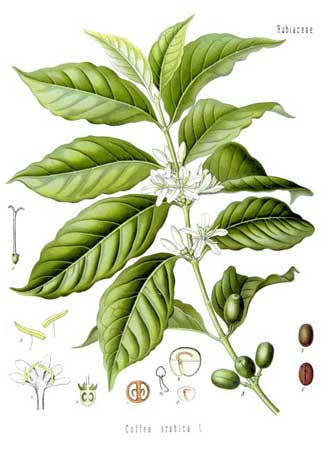
Coffea arabica illustration
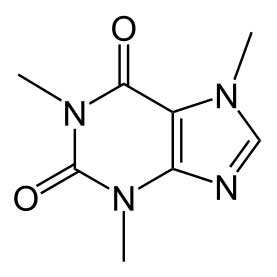
The chemical structure of caffeine.
Coffee also contains another alkaloid chemical called theobromine. Theobromine stimulates our heart and acts as a subtle nervous system stimulant. Furthermore, when our liver breaks down caffeine, more theobromine and another alkaloid named theophylline is produced as metabolite by-products.
Sidenotes:
Caffeine also acts as a bronchodilater. This means caffeine can increase airflow in your lungs. So…if you’re having an asthma attach and can’t find your inhaler, reach for the nearest cup of coffee. You should get some relief.
Coffee is not the only plant that contains caffeine. Guarana, kola nut and mate tea also contain high levels of stimulating caffeine. We’ll discuss these plants later.
EthnoHerbalist recommends…
I like light roast Black Rifle coffee because they support the military and first responders. Their coffee blends are designed to optimize mental energy levels. Click here to order Black Rifle coffee.
L-theanine
Have you ever noticed that drinking tea can be stimulating while also calming? Well, it seems that L-theanine is the chemical that’s responsible for that effect.
In the 1950s, scientists discovered that leaves from the tea plant (Camellia sinensis) naturally produce this interesting compound. If you drink a cup of green tea, you’re getting about 30 mg of caffeine – but you’re also getting about 10 mg of L-theanine.
L-theanine is structurally similar to the amino acids: glutamate and glutamine. This makes sense, as L-theanine also contributes the savory, umami type of flavor that can be tasted in many green teas.
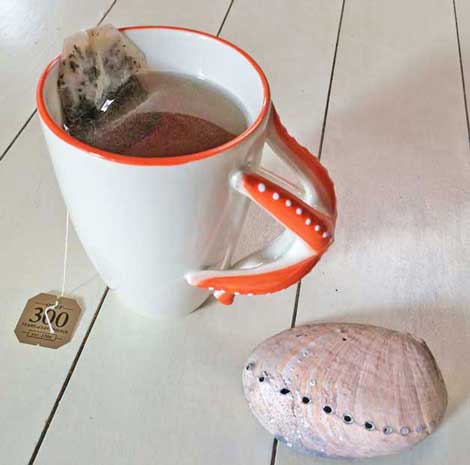
L-theanine is found in a cup of green tea
L-theanine has many reported benefits – including arousal, alertness and cognition.
Interestingly, theanine is also thought to reduce anxiety symptoms. In contrast to caffeine, L-theanine does not make people jittery.
One report worth reading describes how the combination of caffeine and L-theanine led to improvements in brain function, including:
- faster reaction time
- faster working memory
- more accurate sentence verification
A separate neurobiology paper reviews the proposed mechanism of action for L-theanine. In other words, the author attempts to explain how this compound could stimulate our brain while also keeping us calm.
To summarize their findings…
The improvements in learning and memory are attributed to the regulation of NMDA related long term potentiation. Long term potentiation (LTP) is a brain activity that helps form memories. Meanwhile, the calming effect or anxiety-reducing effect may be related to L-theanine’s ability to regulate serotonin, dopamine and other inhibitory neurotransmitters in specific regions of our brain (Lardner, 2014).
EthnoHerbalist recommends…
Drinking black or green tea will provide a small amount of L-theanine. Each cup of tea delivers about 20-30 milligrams of L-theanine.
However, most folks require about 200 mg. of L-theanine to feel the full effect. This could mean 10 cups of tea….which also means you’re consuming a lot of caffeine.
When I’m working on a big project but don’t want any more caffeine in my body, I take 200 mg. L-theanine capsules.
I prefer NOW L-Theanine 200 mg. NOW has been around for awhile and has a solid reputation in the supplement world.
Coconut oil
Coconut oil is pressed from the soft meat of mature coconuts. These coconuts grow on the coconut palm tree (Coccos nucifera).
Coconut oil is unique in that – it has a very amount of saturated fats. In fact, natural coconut oil is about 90% saturated fat.
As you may remember, we are supposed to avoid saturated fats because they can lead to high cholesterol levels. Well, as it turns out, not all saturated fats are created equal. Certain types of saturated fats offer positive health benefits.
Much of the saturated fats in coconut oil are called medium-chain triglycerides, or MCTs. According to specialists, MCTs are especially easy for our body to digest and convert into energy. Additionally, at least one report has been published linking coconut oil to weight loss.
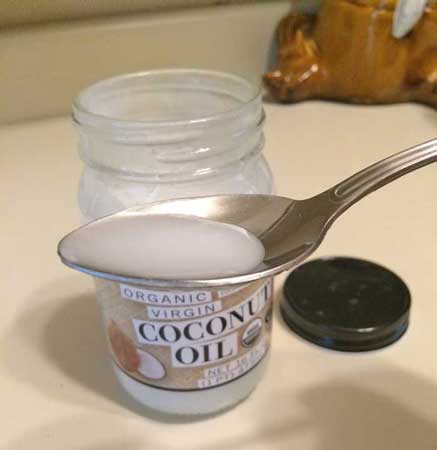
A spoonful of coconut oil
Dr. Dom D’Agostino describes the connection between coconut oil and energy levels, ketosis and fat-burning in our body. If you’re interested in the subject you can listen to this podcast discussion between Tim Ferris and Dom D’Agostino.
EthnoHerbalist recommends…
I’m in the habit of mixing coconut oil into my morning coffee. Onnit makes a high quality MCT coconut oil that can be stirred into hot or cold drinks. They have a few different varieties. This triple pack is a good place to start. Onnit coconut oil is derived 100% from coconuts (as opposed to environmentally damaging palm oil). Their oil also contains the preferred C8, C10 and Lauric acid forms of MCT oil.
If you’re looking for a coconut oil to use for cooking, I like Nutiva Organic Coconut Oil. This oil can be used at higher temperatures than virgin coconut oil and it has a more subtle flavor (i.e. less coconut-y taste) than a virgin coconut oil.
Gotu kola
Gotu kola is a small, delicate herb from the Parsley family of plants. This is the same family that includes the carrot. This scientific name for gotu kola is Centella asiatica. As you may expect from the species name, gotu kola is native to the swampy, wetlands of Asia.
The leaves and stems of gotu kola have been used in traditional medicine for a long time. This herb appears in the ancient texts of Traditional Chinese Medicine, traditional African medicine and Ayurvedic medical books from India.
Historically, gotu kola has been used for many different ailments (skin conditions, varicose veins), however we are most intrigued with its ability to help enhance mental clarity.
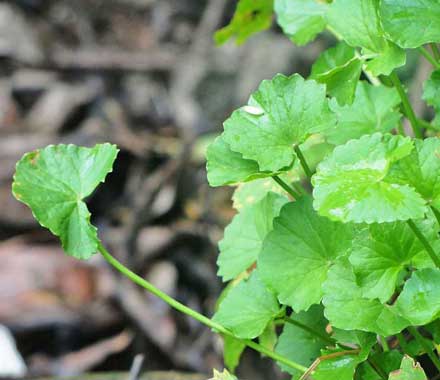
Photo: Shashidhara halady (CC BY-SA 4.0)
Gotu kola plant growing in India
Recent reports have explored the ability of gotu kola to improve brain function and focus.
One report found that use of gotu kola could strengthen brain function in a group of healthy elderly people. Their overall mood and their working memory improved upon treatment with gotu kola extract.
Another report explored the ability of gotu kola to help maintain mental focus and decrease anxiety. To test these features, the scientists used the acoustic startle response test. Human subjects were given a 12 gram dose of gotu kola (this is a very high dose). The authors concluded that gotu kola did result in improvements in the startle response, suggesting the plant can help reduce anxiety and and enhance focus.
Sidenote: Gotu kola and kola nut are NOT the same thing. They are completely different plants. Kola nut contains high amounts of caffeine, however, there is no caffeine in gotu kola. In fact, biochemists have determined that the active chemical in gotu kola is a triterpenoid compound named asiaticoside.
EthnoHerbalist recommends…
Nature’s Way produces a whole herb Gotu Kola capsule that is incredibly popular on Amazon. Nature’s Way is a large supplement company that has maintained their integrity as they’ve grown in size.
If you’re interested in a plant extract, I recommend Herb Pharm Gotu Kola Extract. Herb Pharm is one of the beloved, smaller herb companies. They use alcohol in this tincture in order to best extract the active ingredients from the plant.
Kola nut
The kola nut is the seed of the kola tree. This tree is native to tropical rain-forests throughout Africa. In Nigeria and other west African nations, the chewing of the kola nut has become integrated into traditional ceremonies as well as casual social events. Similar to coffee, the kola nut is packed with caffeine.
Because of its caffeine content, the kola nut is used to combat fatigue and mental slowness. Its also used in food and drinks to add flavor and color.
Kola nut played an important role in the design of one of the most famous sodas in the world, Coca-Cola.
In 1886, John Pemberton, a pharmacist living in Georgia, combined carbonated water with extract from kola nut and the Peruvian coca leaf. The coca leaf actually provided this drink with a small amount of cocaine. This concoction soon became quite popular in the local soda fountain shops. John named his creation Coca-Cola.
The ‘Cola’ in the name is a tip of the hat to the kola nut ingredient. The ‘Coca’ is an acknowledgement of the cocaine plant. As you might imagine, neither kola nut nor the Peruvian coca leaf remain in Coca-Cola today.
Return to our list of natural brain stimulants.
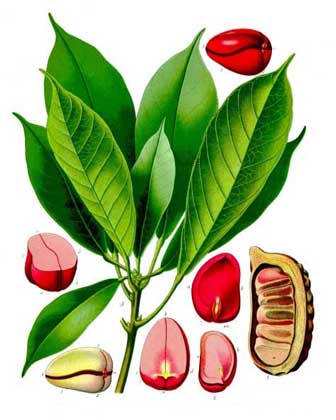
Illustration of the kola nut plant from Köhler’s Medicinal Plants (1887).
Rhodiola rosea
Rhodiola rosea is a rugged plant from the stonecrop family. I say rugged because the plant is often found growing on windy, seaside cliffs as well as mountain tops across northern Asia.
Siberians have been using this herb for centuries as a means to deal with the physiological stress of their cold winter season. The plant is now widely used as a means to reduce mental fatigue.
Russian biochemists performed a lot of work on Rhodiola throughout the past 100 years. Eventually, they isolated a chemical called salidroside from the plant. Salidroside is believed to be responsible for many of the physiological effects of Rhodiola.
Russians scientists were also the first to describe the Rhodiola plant as adaptogenic. This means the plant can reduce stress and encourage homeostasis within the body.
Clinical trials for Rhodiola can be contradictory. That said, there are a handful of publications that demonstrate Rhodiola’s capacity to clear away mental fog.
A Phase III trial performed in Sweden tested mental performance on a group of 60 human subjects. The patients that received Rhodiola reported significant improvements as determined by the Pine’s burnout scale (a test of fatigue) and a test for mental health (SF-60). The authors conclude that repeated use of Rhodiola lends an anti-fatigue effect that can increase mental performance.
If you are interested in more information on the science and cultural history of this plant, please read my full review of Rhodiola rosea.
EthnoHerbalist recommends…
Gaia Herbs sells full spectrum capsules of Rhodiola Rosea. They wild-harvest their Rhodiola from the mountains of Siberia. Gaia Herbs is based in North Carolina, they are one of our favorite, small herbal supplement companies. They’re a very eco-friendly and trustworthy organization.
Herb Pharm, a herb company based in southern Oregon, produces a popular tincture of Rhodiola Root extract. They use organic cane alcohol to extract the active ingredients from the plant. If you’re a recovering alcoholic, you may want to avoid alcohol tinctures.
Guarana
Guarana is a climbing plant in the Maple family. This bushy plant grows comfortably in Brazil and the broader Amazon Basin.
Similar to coffee and kola nut, guarana is packed full of caffeine and is well-respected for its ability to reduce fatigue.
Consuming caffeine leads to the stimulation of the central nervous system, heart stimulation, increase in blood pressure and the stimulation of skeletal muscles.
Guarana also contains theobromine and theophylline.
Many people will feel a different type of buzz from coffee, mate, kola nut or guarana. This is largely attributed to 2 things:
- difference in the amount of caffeine in each plant
- varying ratios of theobromine and theophylline in each plant
Each plant has a unique ratio of these secondary xanthines. Subtle differences in the ratio of caffeine, theobromine and theophylline will effect the way the drink is perceived.
Lately, guarana has been showing up in lots of different energy drinks. You may hear people refer to the stimulating guarana compound as guaranine. Don’t be fooled, guaranine is just another name for caffeine. Below we’ll discuss more plants containing stimulants other than caffeine.
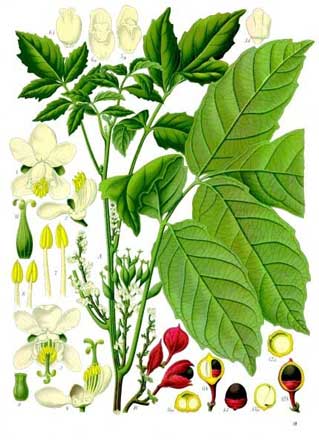
Illustration of the guarana plant from Köhler’s Medicinal Plants (1887).
EthnoHerbalist recommends…
If you have ever visited Brazil, you probably had a can of Antarctica soda. I remember drinking these on Ipanema Beach in Rio. This soda is made from the guarana fruit. Like most soda, it is high in sugar…but its also tasty. This may be the only time I have endorsed a soda on this website.
If you would like to skip the sugar and the nostalgia for Brazil, then Source Naturals makes tablets of Guarana extract. There’s 200 mg. of caffeine in each pill. As I mentioned in the article, you also get the other secondary molecules (theophylline and theobromine).
Mate
Mate is a traditional drink from South America. The leaves of the yerba mate plant (Ilex paraguariensis) are chopped up, steeped in hot water and drank as a hot beverage. Mate also goes by the name Yerba Mate and chimarrão (Portugese).
The first people to drink mate were the indigenous Guaraní people living in southern Brazil. After European colonization of Brazil in the 16th century, the drink spread throughout Spain and then into much of the world.
If you want to be traditional, you’ll hold your mate in a hollowed out gourd and drink the concoction through an ornate straw called a bombilla (see photo).
Mate is well known for its stimulating effects. The leaves of the yerba mate plant contain the same xanthine alkaloid compounds as coffee:
- caffeine
- theophylline
- theobromine
When people talk about the mateine chemical, they are just referring to caffeine from the mate plant.
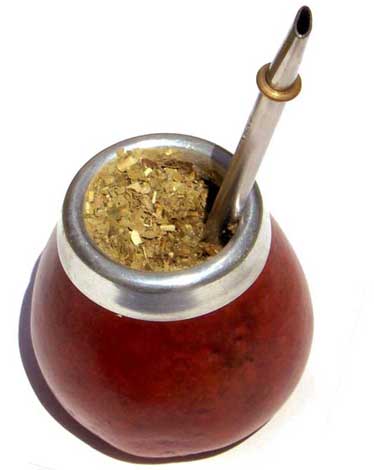
Photo: Jorge Alfonso (CC BY-SA 2.5)
Mate leaves prepared in a traditional Calabash gourd
EthnoHerbalist recommends…
In terms of mate, I’ve always gone with Guayaki. Guayaki is the first Fair Trade certified yerba mate company in the world (through IMO). This was awarded in 2009. The company is very committed to passing on their good fortune to the rainforest communities that supply their mate leaves. I use their loose leaf tea, Guayaki Yerba Mate, 1 lb. loose tea.
Oat Straw
Oats are an unlikely source of mental stimulation.
But sure enough, many people skip the crash and burn effect of caffeine and turn to oat straw for a more sustained energy boost.
The green oat material is from the common oat plant, Avena sativa. This is the same plant that ends up in our breakfast cereals and granola bars. Apparently, when the plant is harvested earlier in the season during the green, flowering stage, there are certain properties in the milky stage grain that help activate our brains.
A handful of experiments suggest that consuming oat straw will increase energy and enhance mental function.
One group used EEG spectral frequencies to show that eating oat straw led to heightened electrical activity in the left fronto-temporal area of the brain. This type of brainwave activity is associated with being alert and mentally aroused. The authors conclude that oat straw may very well be effective at raising cognitive performance.
I’ve never tried oat straw, but I’ve heard it supplies a more subtle, sustained energy and that this energy can last throughout the day.
EthnoHerbalist recommends…
Oat straw is sold as part of a brain stimulant supplement called Alpha Brain. These capsules contain oat straw as well as other earth grown ingredients: cat’s claw, bacopa and huperzine-A. Alpha Brain is arguably one of the most popular natural stimulant supplements. Onnit, the company that produces Alpha Brain, has published clinical data to illustrate how these capsules enhance mental function, you can examine that research here. I’ve been using this stuff since January 2017 and definitely notice an effect.
Ashwagandha
Ashwagandha is the common name for Withania somnifera.
This is a short, leafy plant in the nightshade family. Nightshade plants also include: tomatoes, potatoes and eggplant.
If you have any familiarity with Ayurvedic medicine, then you’ve likely heard of ashwagandha. Ayurveda is a traditional system of medicine that originates from India. The ashwagandha plant is used by practitioners of Ayurvedic medicine to address a range of conditions.
The red berries and leaves are applied to treat skin conditions. The long, slender roots are ground up into a powder. This powder is mixed with milk and honey and drunk in response to stress, pain, epilepsy, arthritis, ext.
Ashwagandha is often referred to as an adaptogen, as its thought to help our body adjust to stress. Interestingly, this plant is also used to help reduce fatigue and improve mental energy.
One study examined brain function in a group of patients suffering from bipolar disorder. The scientists found that ashwagandha provided significant improvements in 3 different cognitive tests (auditory-verbal working memory, Flanker response time and social cognition response.)
The authors acknowledge this data is preliminary but suggest ashwagandha can help cognitive function in patients suffering from bipolar disease.
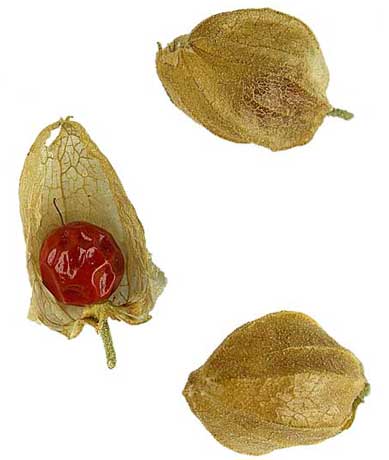
Photo: Roger Culos (CC BY-SA 3.0)
Fruit of the ashwagandha plant
Ashwagandha has also been used to reduce fatigue. This fatigue effect has been explored in a study involving breast cancer patients.
Cancer patients are often treated with chemotherapy to kill off their cancer cells. One of the side effects of chemotherapy is fatigue. This small study showed that breast cancer patients undergoing chemotherapy can experience a reduction in fatigue if treated with ashwagandha. While this report is intriguing, it would be nice to see this effect repeated in a larger group of healthy individuals.
EthnoHerbalist recommends…
As ashwagandha is derived from Indian and Ayurvedic culture, it makes sense to purchase this herb from a reliable Indian company. Organic India is my favorite Asian supplement company. These capsules of Ashwagandha from Organic India are grown and cultivated on sustainable, organic farmland. They are GMO free, gluten free, and vegan. They are also Kosher & Halal Certified.
Bacopa
Bacopa monnieri is a low, creeping water plant that is native to the wetlands of southern India. This small herb grows comfortably in swamps and ponds.
Similar to Ashwagandha, Bacopa is a popular medicinal plant within the Ayurvedic system of medicine. Indians refer to Bacopa as Brahmi. This is a tip of the hat to Brahma, the Creator God of Hinduism.
For centuries, Ayurveidc practitioners have made the claim that Bacopa can improve mental function (i.e. act as a cognitive enhancer).
Recent scientific reports suggest there is a biological basis behind some of these historical health claims.
This plant is used in response to ADHD, poor memory, Alzheimer’s disease and anxiety disorders.
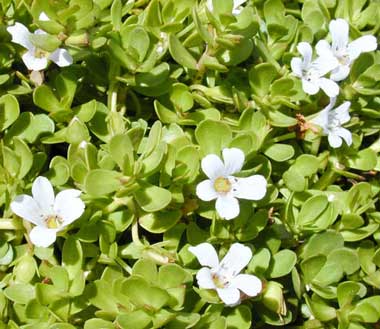
Photo: Forest & Kim Starr (CC BY 3.0)
Bacopa growing in a swamp
One clinical trial showed evidence that use of Bacopa can enhance free memory recall in healthy adults. Another published report demonstrates some improvement in memory and hand-eye coordination among a group of young children taking Bacopa.
How does Bacopa work as a herbal stimulant?
The short answer is…we don’t really know how Bacopa works.
Using laboratory animals, scientists have observed Bacopa increasing cerebral blood flow and inhibiting an enzyme that degrades acetylcholine. Both of these effects would certainly alter mental activity.
Its likely that the active chemicals within Bacopa monnieri are a series of triterpenoid glycosides, called bacosides. Chemists have isolated these chemicals from the plant. However, at this moment, it remains unclear whether the bacosides are responsible for any memory enhancement.
Nootropic supplement companies commonly include Bacopa in their cognitive enhancing formulas.
EthnoHerbalist recommends…
Bacopa is sold as part of a brain stimulant supplement called Alpha Brain. These capsules contain Bacopa as well as other earth grown ingredients (cat’s claw, huperzine-A and oat straw). Alpha Brain is arguably one of the most popular natural stimulant supplements. Onnit, the company that produces Alpha Brain, has published clinical data to illustrate how these capsules enhance mental function, you can examine that research here. I’ve been using this stuff since January 2017 and definitely notice an effect.
Artichoke extract
Who doesn’t like a good artichoke dip? Its the perfect compliment to corn chips. My parents love artichoke, so I grew up dipping steamed artichoke leaves in heated butter.
My parents didn’t know it at the time, but they were feeding me a brain activating food.
The leaves of the common artichoke (Cynara scolymus) are a rich source of PDE4 inhibitors. Now, I know what you’re thinking. What on earth is a PDE4 inhibitor??
Well, it turns out – PDE4 inhibitors can help us stimulate our brains and form stronger memories.
PDE4, also known as phosphodiesterase-4, is an enzyme that works in our brain cells to break apart cAMP molecules. We need cAMP molecules in our brain cells. They help us form memories through LTP (long-term potentiation).
A PDE4 inhibitor will prevent the breakdown of cAMP. That leaves us with higher levels of cAMP in our brain. Our brain then benefits from this abundance of cAMP.
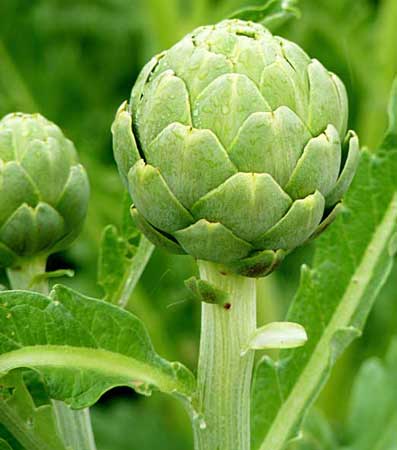
Photo: Jamain (CC BY-SA 3.0)
An artichoke blooming in a French pasture
Scientific reports demonstrate how a PDE4 inhibitor can reduce fatigue and also lead to an increase in cognition (mental processing).
Sidenote: Artichoke extract is often taken in combination with forskolin. This report found that the 2 substances work synergistically in our hippocampus to induce LTP / memory formation. Forskolin is found naturally in the root of the Indian Coleus plant. This chemical can also boost cAMP levels in our brain. I haven’t seen enough safety information about forskolin, so I’m not going to discuss it any further on this page.
American ginseng
Ginseng is a leafy plant with an odd shaped root. Its cultivated all across the world but is most famous for its prominent role in Traditional Chinese Medicine.
There are actually 3 types of medicinal ginseng.
- American ginseng (Panax quiquefolius)
- Asian ginseng (Panax ginseng)
- Siberian ginseng (Eleutherococcus senticosus)
Each of these ginseng species has their own internal biochemistry. And each of these species are used for different reasons by different people around the world.
For the sake of this article, I am focusing on American ginseng (Panax quiquefolius), as this species is used to reduce fatigue and improve mental focus.
American ginseng is native to North America, although the plant is now widely cultivated throughout China. As you can see in the photo, this species has a thick root that forks in the middle.
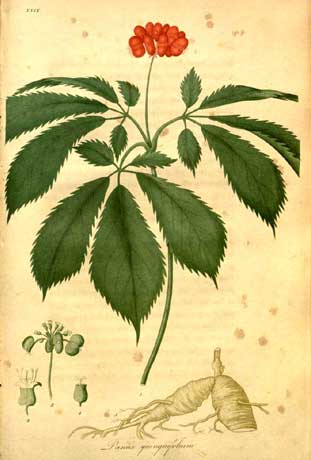
Sketch of American ginseng from American Medical Botany (1820)
Similar to Asian ginseng, American ginseng is full of saponin compounds. These compounds are referred to as ginsenosides. Ginsenosides are the major biologically active chemicals found in American ginseng.
So, what are these ginsenosides doing?
Well, we don’t really know. However, this plant has a devout group of followers that swear by its powers. Ginseng is regarded by many to be a panacea. A panacea is a cure-all type of herb.
In general, I’m skeptical when I hear that a plant can help all sorts of problems with the human body. However, in regards to energy levels and brain stimulation, American ginseng seems to be effective.
American ginseng is thought to reduce fatigue. To test this claim, a group of scientists designed an experiment to ask whether treatment with American ginseng could reduce the fatigue felt by cancer survivors.
Fatigue, or persistent low energy, is one of the many challenges associated with fighting cancer. It seems that the American species of ginseng can help with this issue.
A multi-site, double-blind trial was performed on 364 cancer survivors from 40 different institutions. Patients were tested with the Fatigue Symptom Inventory-Short Form (MFSI-SF) at 4 and 8 weeks after ginseng treatment began.
The authors of this study conclude that – after 8 weeks – the patients whom received 2 grams of American ginseng were significantly less fatigued compared to the placebo control group. Additionally, no toxic side effects were observed with the ginseng treated group.
Sidenote: A 364 person trial is a large endeavor. Its very rare to see a 100+ patient study performed outside of the big-money, pharmaceutical industry.
Another report examined the cognitive effect of American ginseng on a group of 32 healthy adults. Compared to a placebo-controlled group, patients that received an extract of American ginseng reported significant improvements in working memory (WM).
EthnoHerbalist recommends…
As I have focused the above research on American ginseng, I will mention a trust-worthy brand of this particular plant species. NOW sells these capsules of American ginseng. NOW is one of the companies that ranked very highly when I performed my own market research on dependable supplement companies of North America.
Maca
Maca is a fascinating plant from the Peruvian highlands. The ancient Inca people of Peru were especially fond of this plant. According to legend, Inca warriors routinely ate maca root before they charged into battle. The plant was believed to boost their strength and endurance.
The Incas must have had the right idea, because now – 600 years later – professional athletes still routinely take maca supplements. Sportsmen report feeling improvements in strength and endurance after eating this plant.
Personally, I am now in the habit of adding a tablespoon of maca to my coffee.
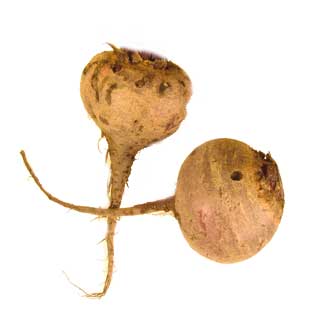
Thick roots of the maca plant
This small study explored the claim that maca can enhance athletic performance. A group of cyclists rode for 40 km on their bike. These athletes then took a maca supplement for 14 days and repeated the 40 km ride. After taking maca extract, the cyclists performed significantly better than their initial baseline ride. While this is only a small, preliminary human trial. The results do corroborate with our historical evidence regarding maca usage by the Inca community.
I previously wrote a longer article on the additional health benefits of maca (female sex drive, male libido and menopause issues). In this article, I also discuss the different factors to consider when choosing a maca supplement.
EthnoHerbalist recommends…
Maca powder has a unique nutty flavor that can be added to smoothies or coffee. I get my maca powder from Viva Labs. This maca is organic and sourced directly from Peruvian farmers in accordance with fair trade practices.
If you prefer taking your maca in a capsule, I recommend Gaia Herbs. Gaia packages 1 gram of maca in liquid phyto-capsules. These plant derived capsules are easy to swallow and digest.
Recent news related to mental clarity (updated 2019)
Circadian rhythm and brain fog
We all know you need a good night’s sleep if you want to function well the next day. The research on this topic keeps becoming stronger.
A 2019 report in Nature Communications identified 320 genes that can influence whether you stay up late or head to sleep early. Previous studies demonstrate that night owls are more likely to be obese, depressed and suffer from type 2 diabetes. These 320 genes may provide the causal link between chronic ailments and sleep patterns.
When is the best time to eat dinner?
It seems we really need to align our eating hours with the movement of the sun. When we eat late at night, we disrupt our body’s natural circadian rhythm. In doing so, this can lead to us disrupting our metabolism, putting on weight and walking around with brain fog. Please read this NYT article for more information. But basically, no more late night snacks!. Eat your dinner as the sun is going down. Then shut it down.
We’re designed to have 24-hour rhythms in our physiology and metabolism. These rhythms exist because, just like our brains need to go to sleep each night to repair, reset and rejuvenate, every organ needs to have down time to repair and reset as well.
-Dr Satchin Panda
Sleep deprivation may increase chance of Alzheimer’s disease
Alzheimer’s disease has been a difficult nut to crack. We seem to understand some of the biology that leads to this neurodegenerative disease, however, it is clear we don’t understand all of the cell biology. We do know that build-up of beta amyloid is linked to impaired brain function and Alzheimer’s disease. What is beta-amyloid? It is a metabolic waste product that accumulates in the region between neurons (brain cells). This is normal, however, there seems to be a correlation between clumping of beta-amyloid plaques and the onset of Alzheimer’s disease. When these plaques reach a significant level, our brain cells fail to communicate properly.
Research demonstrates that a good night’s sleep can remove beta-amyloid from our brain. This may explains why we can feel so crisp after 8 hours of sleep. Much of this work has been performed in mice. A new study has revealed this effect is also observed in human patients.
The researchers scanned participants’ brains after getting a full night’s rest and after a night of sleep deprivation. Beta-amyloid increased about 5% in the participants’ brains after losing a night of sleep. These changes occurred in brain regions that included the thalamus and hippocampus, which are especially vulnerable to damage in the early stages of Alzheimer’s disease.
Keep in mind, this was a small study of less than 50 people. A follow up study with a few hundred humans could help strengthen this finding. We will keep you posted.
This concludes our list of natural brain stimulants.
The list is a work in progress, so please bookmark the page and return often.
I’ll be updating the page each year as new research is published on these plants.
Thanks for stopping by!
Check out more EthnoHerbalist articles on effective medicinal plants.
References
American ginseng
Scholey, Andrew, et al. “Effects of American ginseng (Panax quinquefolius) on neurocognitive function: an acute, randomised, double-blind, placebo-controlled, crossover study.” Psychopharmacology 212.3 (2010): 345-356.
Barton, Debra L., et al. “Wisconsin Ginseng (Panax quinquefolius) to improve cancer-related fatigue: a randomized, double-blind trial, N07C2.” Journal of the National Cancer Institute 105.16 (2013): 1230-1238.
Rhodiola rosea
Olsson, Erik MG, Bo von Schéele, and Alexander G. Panossian. “A randomised, double-blind, placebo-controlled, parallel-group study of the standardised extract shr-5 of the roots of Rhodiola rosea in the treatment of subjects with stress-related fatigue.” Planta medica 75.02 (2009): 105-112.
Maca
Stone, Mark, et al. “A pilot investigation into the effect of maca supplementation on physical activity and sexual desire in sportsmen.” Journal of ethnopharmacology 126.3 (2009): 574-576.
Artichoke extract
Lelkes, Z., et al. “Rolipram, an antidepressant that increases the availability of cAMP, transiently enhances wakefulness in rats.” Pharmacology Biochemistry and Behavior 60.4 (1998): 835-839.
Barad, Mark, et al. “Rolipram, a type IV-specific phosphodiesterase inhibitor, facilitates the establishment of long-lasting long-term potentiation and improves memory.” Proceedings of the National Academy of Sciences 95.25 (1998): 15020-15025.
Lion’s mane
Mori, Koichiro, et al. “Improving effects of the mushroom Yamabushitake (Hericium erinaceus) on mild cognitive impairment: a double‐blind placebo‐controlled clinical trial.” Phytotherapy Research 23.3 (2009): 367-372.
Mori, Koichiro, et al. “Nerve growth factor-inducing activity of Hericium erinaceus in 1321N1 human astrocytoma cells.” Biological and Pharmaceutical Bulletin 31.9 (2008): 1727-1732.
Bacopa
Stough, Con, et al. “Examining the nootropic effects of a special extract of Bacopa monniera on human cognitive functioning: 90 day double-blind placebo-controlled randomized trial.” Phytother Res 22.12 (2008): 1629-34.
Pase, Matthew P., et al. “The cognitive-enhancing effects of Bacopa monnieri: a systematic review of randomized, controlled human clinical trials.” The Journal of Alternative and Complementary Medicine 18.7 (2012): 647-652.
Sivaramakrishna, Chillara, et al. “Triterpenoid glycosides from Bacopa monnieri.” Phytochemistry 66.23 (2005): 2719-2728.
Ashwagandha
Mishra, Lakshmi-Chandra, Betsy B. Singh, and Simon Dagenais. “Scientific basis for the therapeutic use of Withania somnifera (ashwagandha): a review.” Alternative medicine review 5.4 (2000): 334-346.
Chengappa, KN Roy, et al. “Randomized Placebo-Controlled Adjunctive Study of an Extract of Withania somnifera for Cognitive Dysfunction in Bipolar Disorder.” The Journal of clinical psychiatry 74.11 (2013): 1076-1083.
Biswal, Biswa Mohan, et al. “Effect of Withania somnifera (Ashwagandha) on the development of chemotherapy-induced fatigue and quality of life in breast cancer patients.” Integrative cancer therapies 12.4 (2013): 312-322.
Gotu kola
Wattanathorn, Jintanaporn, et al. “Positive modulation of cognition and mood in the healthy elderly volunteer following the administration of natural mental stimulant Centella asiatica.” Journal of ethnopharmacology 116.2 (2008): 325-332.
Bradwejn, Jacques, et al. “A double-blind, placebo-controlled study on the effects of Gotu Kola (Centella asiatica) on acoustic startle response in healthy subjects with a herbal stimulant. Plant stimulants other than caffeine.” Journal of clinical psychopharmacology 20.6 (2000): 680-684.
Wan, JingYuan, et al. “Antipyretic and Anti‐inflammatory Effects of Asiaticoside in Lipopolysaccharide‐treated Rat through Up‐regulation of Heme Oxygenase‐1.” Phytotherapy Research 27.8 (2013): 1136-1142.
L-theanine
Haskell, Crystal F., et al. “The effects of L-theanine, herbal stimulants, caffeine and their combination on cognition and mood.” Biological psychology 77.2 (2008): 113-122.
Lardner, Anne L. “Neurobiological effects of the green tea constituent theanine and its potential role in the treatment of psychiatric and neurodegenerative disorders.” Nutritional neuroscience 17.4 (2014): 145-155.
Huperzine A
Xing, Shu-huai, et al. “Huperzine A in the treatment of Alzheimer’s disease and vascular dementia: a meta-analysis of natural brain stimulants.” Evidence-Based Complementary and Alternative Medicine 2014 (2014).
Yang, Xin, et al. “Combining antioxidant astaxantin and cholinesterase inhibitor huperzine A boosts neuroprotection.” Molecular Medicine Reports (2020).
Oat straw
Dimpfel, Wilfried, Charlotte Storni, and Marian Verbruggen. “Ingested natural stimulant oat herb extract (Avena sativa) changes EEG spectral frequencies in healthy subjects.” The Journal of Alternative and Complementary Medicine 17.5 (2011): 427-434.
Coconut oil
Assunçao, Monica L., et al. “Effects of dietary coconut oil on the biochemical and anthropometric profiles of women presenting abdominal obesity.” Lipids 44.7 (2009): 593-601.
